Matisse: Radical Invention, 1913–1917
The Museum of Modern Art, New York
18 July–11 October 2010
by MICHAEL PATRICK HEARN
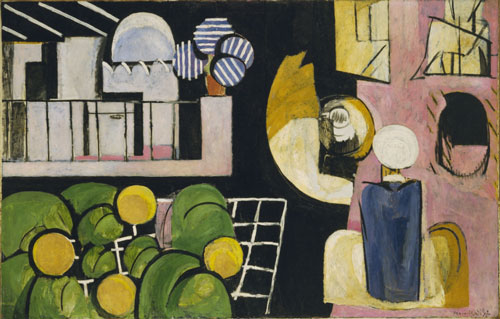
Henri Matisse. The Moroccans. Issy-les-Moulineaux, late 1915 and fall 1916. Oil on canvas, 71⅜ x 110 inches (181.3 x 279.4 cm). The Museum of Modern Art, New York, Gift of Mr and Mrs Samuel A Marx. © 2010 Succession H. Matisse/Artists Rights Society (ARS), New York.
Matisse: Radical Invention, 1913–1917 is the art exhibition to see in New York – and more than once. Before anyone quibbles about yet another Matisse show, consider that MoMA and Chicago have taken out of storage and from many public and private collections rarely seen works to play off one another in this mammoth undertaking. Although it contains over 100 works, the display is never oppressive. It never feels padded. One eagerly races from one gallery to the next to take it all in. This art all seems still so vigorous and fresh, as radical as ever. The selection reflects the full range of the artist’s vast invention through paintings, sculptures, prints and drawings. Nothing could be more thrilling and satisfying. Matisse: Radical Invention, 1913–1917 defines what a blockbuster should be.
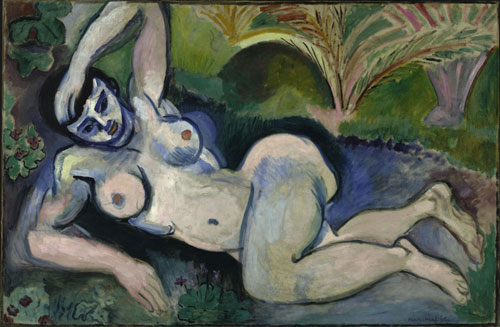
Henri Matisse. Blue Nude (Memory of Biskra), 1907. Oil on canvas, 92.1 x 140.4 cm (36 1/4 x 55 1/4 inches). The Baltimore Museum of Art, The Cone Collection. © 2010 Succession H. Matisse/Artists Rights Society (ARS), New York.
This title, of course, is not only misleading but nonsense. A large number of the works belong to years other than the designated five. They commence with the aggressive Blue Nude (Souvenir de Biskra) of 1907 and continue as late as 1931 when the artist completed the fourth and final “Back” relief. What does “Radical Invention” mean as far as Matisse’s career is concerned? Would not that apply to every phase of it? Naturally MoMA and Chicago rely on their own rich holdings, but the exhibit would have been enhanced in places with pertinent examples from the Hermitage in St. Petersburg and the Barnes Foundation on Philadelphia’s Main Line. The Russian Sergei Shchukin was the great early collector of Matisse, but the dreadful economy may have prohibited any loans. Perhaps it was pointless to try to borrow anything once owned by the idiosyncratic Alfred C. Barnes. Though the masterpieces Dance I (1909) and The Red Studio (1911) too are conspicuously absent, both can be found on another floor of MoMA in the permanent collection.
If Picasso had his Blue and Pink Periods, then 1913 to 1917 might be called Matisse’s Gray Period. The understated palette he now employed drew on subtle shades of gray, blue and rose, some brown and green, all held together by thick black. Some paintings look almost monochromatic or like hand-coloured photographs. There is nothing naturalistic about the hues he chooses. As in the work of Cézanne and many of Matisse’s Cubist contemporaries, the underlying drawing was of greater importance to his paintings than any brilliant colour effects, even though the use of light continued to play a significant part in these pictures. Matisse found radical new ways of applying paint to canvas. He layered, slathered, splashed, slashed, smeared and scratched it. The raw textures invigorate the subdued colours. Matisse, like the revered Cézanne before him, audaciously allowed the bare white of the canvas to show through as another colour.
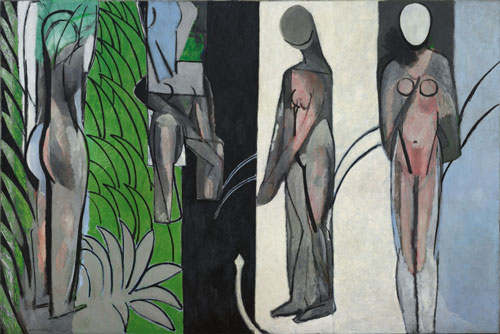
Henri Matisse. Bathers by a River, 1909–10, 1913, 1916–17. Oil on canvas, 102 1/2 x 154 3/16 inches (260 x 392 cm). The Art Institute of Chicago, Charles H. and Mary F. S. Worcester Collection, 1953.158. © 2010 Succession H. Matisse/Artists Rights Society (ARS), New York.
The numerous paintings of bathers in the MoMA show perhaps too conveniently refer back to Cézanne's Three Bathers (1879–1882) that Matisse owned and then look forward to Matisse’s monumental Bathers by the River (1917) from Chicago, the kingpin that closes the exhibit. La Luxe II (1907–1908) looks less like late stolid Cézanne than limp vintage Vallotin; and the coy expression of horror (or is it wonder?) on the central figure in Bathers with a Turtle (1908) wrecks this absurd picture. Yet Bather (1908), a young nude male from the back, is one of the most powerful pictures Matisse ever painted. It is the only one of these swimming paintings comparable in quality to Bathers by a River, one of the master’s masterpieces. Bather embodied everything that Matisse was attempting as an artist at the time.
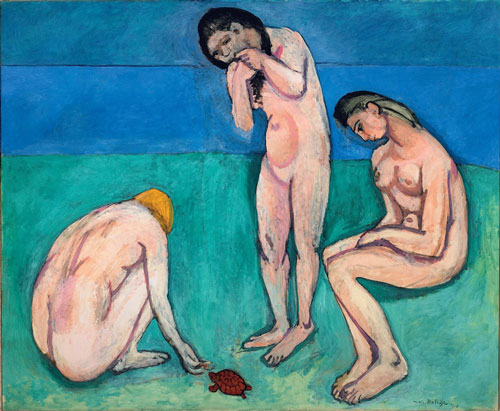
Henri Matisse. Bathers with a Turtle, 1907–08. Oil on canvas, 179.1 x 220.3 cm (70 1/2 x 87 3/4 inches). Saint Louis Art Museum, gift of Mr and Mrs Joseph Pulitzer Jr., 24:1964. © 2010 Succession H. Matisse/Artists Rights Society (ARS), New York.
The African influence is still evident in many of these pictures, particularly the portraits. Like the pencil drawing of Shchukin and the famous Portrait of Madame Matisse (1913) in the Hermitage, Portrait of Sarah Stein (1916) wears a mask instead of a face. So too do The Italian Woman (1916) and Portrait of Auguste Pellerin (II) (1917). The latter sitter rejected an earlier version of the picture, but Matisse was not really interested in capturing exact likenesses. The Italian Woman fades in and out of the background in a composition that fuses Cubist conventions with Matisse’s own concepts of construction. The artist was more concerned with the colours and patterns in The Manila Shawl (1911) than in the woman who wore it. The rather smug Nude with a White Scarf (1909) is just as blunt as any of Picasso’s African-inspired pictures of Parisian prostitutes.
The show really does take off as it progresses from 1913 when the painter returned to Paris from Morocco until his departure for Nice in 1917. Picasso as always was Matisse’s bête noir. Les Demoiselles d'Avignon (1907) forced everyone to entirely rethink art. (Ironically, Matisse was the one who introduced the Spaniard to African art.) Fellow Fauves like Georges Braque and André Derain deserted Matisse for Cubism. No matter how much he might have wanted to, Matisse could not ignore Picasso. Theirs was a heated rivalry that greatly fuelled Modern Art as each artist tried to outdo the other. Not surprisingly, Matisse once compared their relationship to a prizefight. “No one has ever looked at Matisse's paintings more carefully than I,” Picasso confessed and then added with some irony, “and no one has looked at mine more carefully than he”. The show at MoMA proves that Matisse was as revolutionary as Picasso.
Be warned that the Matisse of the current show is not the popular painter of the postcards and posters, the beloved old sensualist obsessed with colour, line and the female form. This is the thinking man’s Matisse, struggling with the precepts of the Cubist Revolution to develop what he called “methods of modern construction”. Most importantly, he shifted from concerns of colour to questions of form as he developed his own distinctive visual shorthand for figure and landscape. Despite his familiarity with Picasso’s efforts, Matisse did not follow anyone. The French poet and critic Guillaume Apollinaire shrewdly observed at the time, “Matisse’s art is eminently reasonable”. Yet the artist himself insisted that he relied only on his instincts.
Working almost solely within his studio, Matisse seemed disengaged from the world outside him. Many of the paintings of this period deal with windows and the play of sunlight streaming through them. Despite the inconveniences the war inflicted on the artist, these pictures and sculptures are entirely divorced from the mayhem then raging around him. Like Bonnard, Matisse was a master of bourgeois domesticity. He sought “an art of balance, of purity and serenity, devoid of troubling or depressing subject matter” that should be “a calming influence on the mind, something like a good armchair which provides relaxation from physical fatigue”. He tried to enlist in the French army but was turned down because he was 44 years old. He continued to busy himself throughout the war with portraits, nudes, interiors, exteriors and still lives just as he had during peacetime. There are no soldiers in uniform, no battle scenes, no reference to or residue of the devastation just beyond his studio. Matisse preferred to draw the precise contours of a piece of fruit on a plate to depicting the violence then destroying the rest of the country. Viewing Matisse’s work done during those turbulent times is as if the First World War never happened. Although he did produce a series of prints to aid the prisoners in Bohain-en-Vermandois in 1914 and 1915, Matisse was not a political artist. Pleasure and the pursuit of happiness alone defined his art.
Not wishing to draw attention to himself with the rest of the world at war, Matisse chose not to exhibit these works as they were being produced. Consequently, critics and scholars have largely neglected this crucial period in his life, until MoMA’s exhibition. Other painters must have been familiar with individual pictures. Portrait of Auguste Pellerin (II) with its predominant black lines suggests Max Beckman’s German Expressionist paintings and Composition (1915) finds echoes in the American Milton Avery’s later art while Branch of Lilacs (1914) and The Rose Marble Table (1916) must have inspired the Russian David Shterenberg.
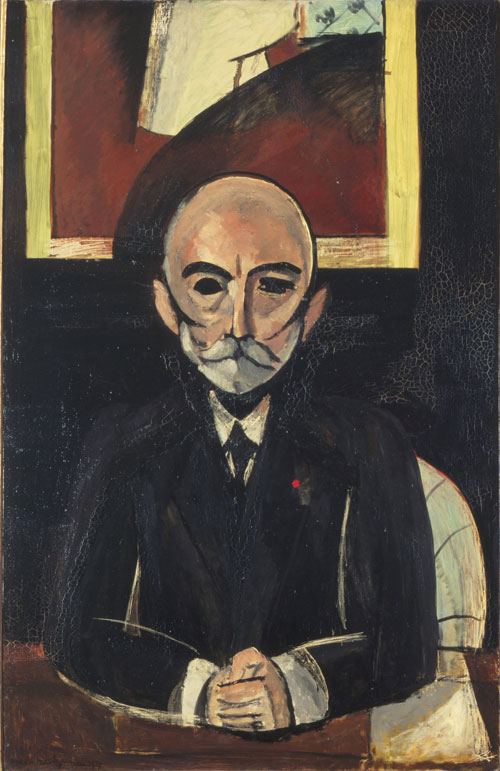
Henri Matisse. Portrait of Auguste Pellerin (II), 1917. Oil on canvas, 59 x 37⅞ inches (150.2 x 96.2 cm). Mus
Particularly fascinating is Matisse’s 1915 deconstruction of his own 1893 student copy of Still Life After Jan Davidsz. de Heem’s “La Desserte” decades before Picasso re-imagined works by Velasquez, Cranach and other Old Masters. Matisse had come across the old picture while going through things he had moved to Issy-les-Moulineaux after the French army requisitioned his home in Paris. Here was a typical painting of the Dutch school relying on heavy chiaroscuro that Matisse discarded when he brightened it up “by adding everything I’ve seen since”. The new work looks like a collage of little still lives done in a variety of manners and yet they all fit together to form a surprisingly integrated composition. It is like a Mini-Master Class in Modernism.
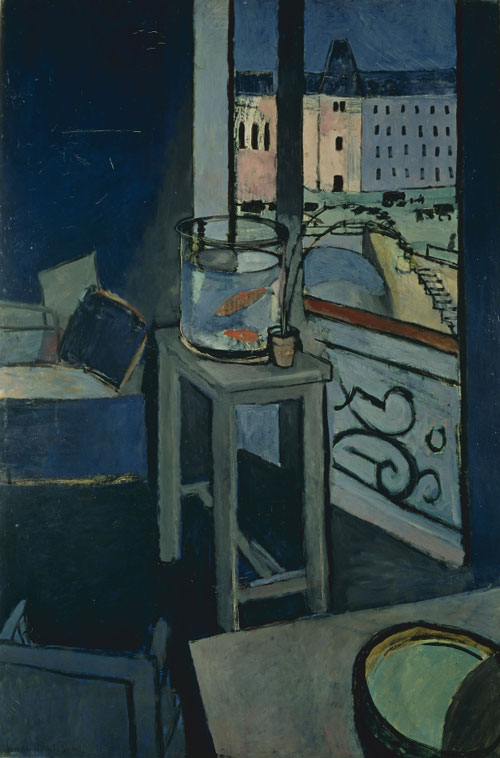
Henri Matisse. Interior with Goldfish, 1914. Oil on canvas, 57 7/8 x 38 1/8 inches (147 x 96.8 cm). Musée National d'Art Moderne/Centre de Création Industrielle, Centre Pompidou, Paris. Bequest of Baroness Eva Gourgaud, 1965.
No matter how commonplace may be his subjects, there is nothing conventional about their rendering. The simple but monumental Apples (1916) and A Vase with Oranges (1916) purify the genre and nearly outdo the grandiose Dutch Masters. The Blue Window (1913) looks back to The Red Studio by displaying some objects, including one of the artist’s sculptures, against a single colour that dominates the room and the rhythmic landscape beyond the pane. The sunlight cuts up Goldfish and Palette (1914–1915) into odd angles. A wide band of black shadow behind the fishbowl gives it and the goldfish a haunting luminosity. Matisse had originally painted himself into the picture on the right; only his thumb in the palette remains. Matisse, much as Cézanne did on his trips to Provence, redefines the very nature of the landscape itself in the colliding slashes of colour in Shaft of Sunlight, the Woods of Trivaux (1917) and the flat geometric shapes of Garden at Issy (1917).
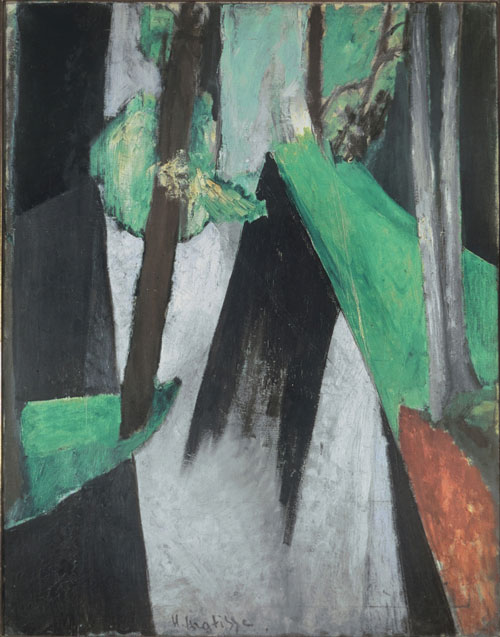
Henri Matisse. Shaft of Sunlight, the Woods of Trivaux, 1917. Oil on canvas, 36 x 29⅛ inches (91 x 74 cm). Private collection. © 2010 Succession H. Matisse/Artists Rights Society (ARS), New York.
Matisse never entirely embraced pure painting, but he came damn close to it during this highly exploratory period. Although never completed, French Window at Collioure (1914) summarises all Matisse was thinking at the time. No more than a view through window into the darkness, it is arguably the most abstract of his works. It is almost a Colour Field painting as a large swatch of black is squeezed between the wide blue-gray stripe of the opened window on the left and the other gray half of it and the green wall on the right. Equally extraordinary is View of Notre Dame (1914), a brash, concise architectural rendering of the famed landmark against a blotchy blue ground. Many people once believed the painter had left it unfinished. Its stark simplicity is not what one expects of Matisse, yet the skeleton of the cathedral is powerful as such. Though few others have realised it, Matisse always insisted that he provided a specific subject in Composition (1915). It is another view from his window with the floral curtain evident on the left. However, the landscape outside has been reduced flat areas of pure colour, a swirl of bright yellow against light blue and green.
The little known and rarely seen prints of this period are the real revelation of this show. The graceful pencil-thin etchings seem to be fighting to break free of the confines of the edge of the plates. The modest monotypes of white lines against velvety black ground sore in their simplicity and clarity. Matisse full realised these often-overlooked still lives in as few strokes as possible.
Matisse took risks. Consequently, not all of his experiments were successful. One obvious dud is Head, White and Rose (1914) that is no more than a lame parody of Cubism. It does not even look like a Matisse. The Portrait of Yvonne Landesberg (1914) too is less than stellar, being more Larionov than Matisse. The rays seem arbitrarily imposed upon the sitter rather than radiating from her, as do the black lines that define the figure of Portrait of Olga Merson (1911). Matisse scraped them apparently with the end of his brush after completing the rest of the Landesberg picture.
The juxtaposition of all these different kinds of art in a single exhibition is often brilliantly done. Nothing seems to clash. It is a pleasure to compare the zaftig Blue Nude with two small 1907 sculptures of another reclining nude nearby; and the bronze heads of Jeanette are conveniently placed beside each other for easy study. Oddly the four muscular bronze Back (1907–1931) reliefs are displayed chronologically, rather than lined up back to back like soldiers as in their usual place in MoMA’s garden. Having to run back and forth in this exhibition to trace their artistic development greatly diminishes their impact.
Modernism often teeters on caricature and Matisse’s work is no exception. Mme. Derain could not have been flattered much by the 1914 etching nor Jeanne Vaderin by his series of brawny bronzes. The rough, rugged, raw Blue Nude seems a parody of the smooth sleek boudoir paintings of the period. Aggressively un-erotic, it still shocks. Not surprisingly Picasso did not care for it. “If he wants to make a woman, let him make a woman,” the Cubist complained when he encountered it in Gertrude Stein’s apartment. “If he wants to make a design, let him make a design.”
These works are often difficult, sometimes frustrating and always fascinating. They beg the viewer to take risks too. One of the most Cubistic of the paintings in form and hue, Woman on a High Stool (Germaine Raynal)” (1914), is a stunning picture and surprisingly reminiscent of Giacometti. The black line gives mass to the figure and the limited colour pushes it forward off the flat canvas. Another major painting in the show, The Moroccans (1915–1916), reduces the Near Eastern scene to its stark geometry against the black background. The clump of green Cubist bushes turns out to be men kneeling in prayer.
Everything comes together in The Music Lesson (1916). The painter’s little boy plays the piano amidst his father’s art while the sunlight through the picture window plays tricks on the living room and upon his young face. A small sculpture from 1908 nestles in the lower left corner with Woman on a High Stool on the wall to the right, suggesting the music teacher as she listens to the child’s fingers exercises behind him or reflected in a mirror. Matisse does not merely copy that earlier painting: he re-conceives it as a distinctive new picture.
If any of this art fails to awe the viewer, it is the drawings. They seem more the means to the end rather than concise, distinctive works done entirely on their own terms. The charcoal and pencil studies of women are more about erasing than drawing. Some sketches from Morocco are no more than doodles lacking the master’s touch. As another artist said in a different context, it is like looking at Matisse in his underwear. Not a pretty sight.
Matisse often reworked his canvases, radically transforming them into almost entirely different works of art. This was particularly true of Bathers by a River. The artist himself called it one of the five most important pictures of his entire career. It is hard to argue with him. It went through a long gestation of six distinct states all carefully documented in the exhibition, a digital survey and the catalogue. The Art Institute of Chicago recently bombarded the picture with a series of scientific investigations to determine exactly its aesthetic evolution. Begun in 1909 originally as a mural for Shchukin’s stairway in his Moscow home, Matisse returned to the picture again and again and ended up with one of the great works of the 20th century. Although likely not his initial intent, the sculpted nudes, now pared down to their simplest forms, could be different views of the same model on four separate panels. Each is rendered slightly differently from every other one. The artist likewise rethought Back in four distinct forms between 1908 and 1931, producing among the most influential sculptures of the modern era. Unlike his pictures that he painted over, Matisse wisely preserved each state of this sculpture.
Now the bad news. The curators have been so caught up in the latest technology that they seem to have lost sight of the art in their exhibition. They are so busy studying the trees that they do not quite see the forest. They have taken X-rays of the pictures and digitally reconstructed the various stages of their development and eagerly put their research on the walls. Doggedly applying modern science to these works drains them of their magic, their mystery, their poetry. “Hast thou not dragged Diana from her car?” wondered Edgar Allan Poe in his Sonnet To Science. The oversized supplemental panels mounted between the pictures are crammed with lots of text and many tiny snapshots. Some discuss paintings missing from the show. Such gratuitous minutiae are more appropriate for an academic dissertation than an art exhibition. All this scholarly stuff encourages unnecessary congestion as patrons plant their feet before the paintings to diligently listen to the banality of the commentary on their headphones as they strain to study the panels. Some may even glance from time to time at the art. There is so much to read and so many little reproductions to look at that it all distracts from the major thrust of the organisers’ fine argument. Better, in fact, to buy the weighty catalogue and study the scholarship at leisure.